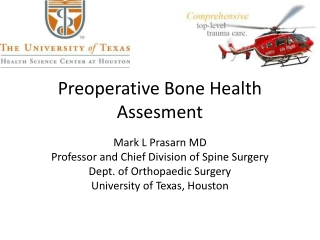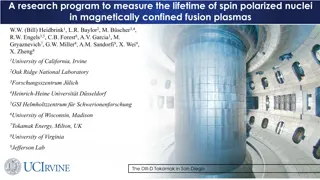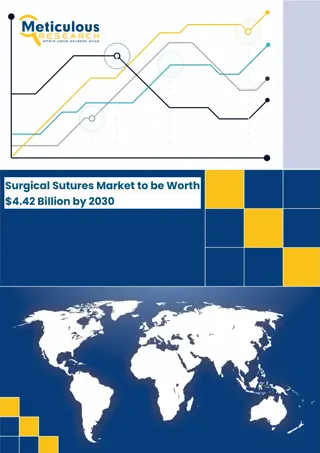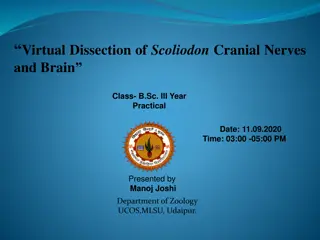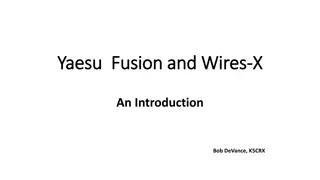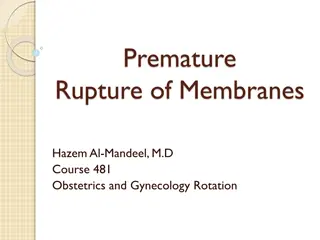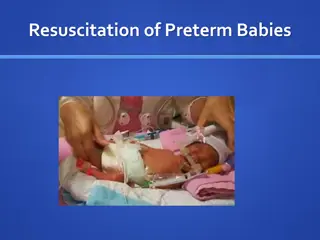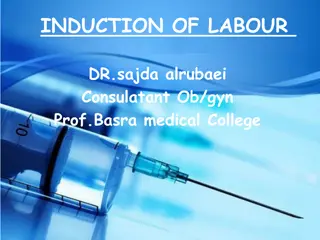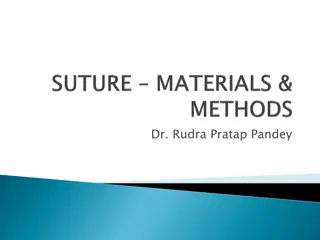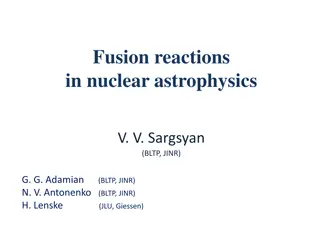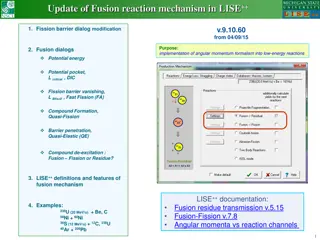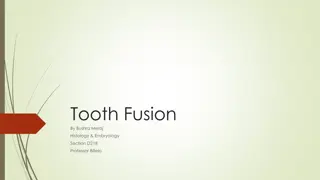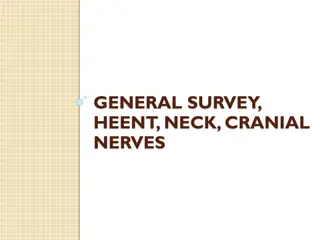Craniosynostosis: Premature Fusion of Cranial Sutures
Craniosynostosis is a pathological condition resulting from premature fusion of cranial sutures, leading to deformities in the cranial vault and base. It affects skull growth and brain development, with closure of sutures and fontanelles occurring by adulthood. Historical insights by Otto and Virchow have contributed to understanding the pathogenesis and classification of this condition. Sutures play a crucial role in allowing growth perpendicular to them, related to brain growth. This condition underscores the importance of early detection and proper management for optimal outcomes.
Uploaded on Sep 17, 2024 | 0 Views
Download Presentation

Please find below an Image/Link to download the presentation.
The content on the website is provided AS IS for your information and personal use only. It may not be sold, licensed, or shared on other websites without obtaining consent from the author. Download presentation by click this link. If you encounter any issues during the download, it is possible that the publisher has removed the file from their server.
E N D
Presentation Transcript
Pathological condition that results from premature fusion of one or more sutures in the cranial vault; Associated with a deformity of the vault and cranial base.
Development Bones of the cranium The skull base and the calvarial vault Growth of skull bones Expanding growth of the brain.
Brain Growth At term has nearly 40 percent of his or her adult brain volume, And this increases to 80 percent by three years of age. Continues to grow until the age of 12 yrs
The cranium At term is 40 percent of adult size; By seven years, this increases to 90 percent. Sun PP, Persing JA. Craniosynostosis. In: Albright AL, Pollack IF, Adelson PD, eds. Principles and practice of pediatric neurosurgery. New York: Thieme Medical, 1999:219-42.
Timing of Closure of Sutures and Fontanelles Type of suture/fontanelle Time to closure Metopic suture Coronal, sagittal, lambdoid sutures Anterior fontanelle Posterior fontanelle Anterolateral fontanelle Posterolateral fontanelle Nine months to two years (may persist into adulthood) 40 years Nine to 18 months Three to six months Three months Two years Adapted with permission from Aviv Ri, Rodger E Hall CM. Craniosynostosis. Clin Radiol 2002;57:94. Mature suture closure occurs by 12 years of age, but completion continues into the third decade of life and beyond.
HISTORY AND PATHOGENESIS Otto ( 1830) coined the term craniosynostosis Stahl and Hyrtl noticed that premature closure of the cranial vault sutures leads to an abnormal skull shape. In 1851, Virchow described how skull growth is restricted to a plane perpendicular to the affected, prematurely fused suture and is enhanced in a plane parallel to it.
Suture Growth Sutures allow growth perpendicular to them Growth at suture lines related to brain growth
Virchow - classify the different types of skull deformity Van der Klaauw, in 1946, and Moss, in 1959. Cranial base source of abnormal physical stress leading to dural abnormalities that yielded premature sutural fusion
Animal studies The cranial vault abnormalities typical of synostosis can be produced with experimental fusion of developing cranial vault sutures. 1. Persing JA, Babler WJ, Jane JA, et al. Experimental unilateral coronal synostosis in rabbits. Plast Reconstr Surg. 1986;77:369 376.
Marsh and Vannier Following cranioplasty in patients with individual suture craniosynostosis in which surgery altered only the cranial vault structure, previously developed cranial base abnormalities were ameliorated Marsh JL, Vannier MW. Cranial base changes following surgical treatment of craniosynostosis. Cleft Palate J. 1986;23(suppl. 1):9.
L.C Lane First surgical procedure to release stenosed suture Lannelogue-1890 performed bilateral strip craniectomies Tessier - Father of modern craniofacial Surgery. First to attempt major surgical procedures on the craniofacial skeleton.
Incidence One per 1,800 to 2,200 live births Males - Sagittal and metopic stenosis Females - Coronal Reefhuis J, Honein MA, Shaw GM, Romitti PA. Fertility treatments and craniosynostosis: California, Georgia, and Iowa, 1993-1997. Pediatrics 2003;111(5 pt 2):1163-6.
Theories of Cranoisynostosis Sommering( 1839) Noted that bone growth in skull primarily occurs at suture line and if it prematurely fused, an abnormal skull shape developed and skull growth restricted. Virchow(1821) and Otto(1830)- Similar observation were made and they noted restriction of growth adjacent to suture and compensatory growth occurred at elsewhere in skull to accommodate growing brain . Jane JA: The major cause of the global cranial deformity was compensatory overgrowth at adjacent sutures. 10/10/2012 Craniosynostosis 14
Theories of Craniosynostosis Moss(1959) Described functional matrix theory. According to this theory cranial base abnormality was the primary pathological process and cranial vault suture abnormality was secondary as cranial base mature embryologically before cranial vault. Persson (1979) Cranial vault suture pathology may be primary in the development of synostosis leading to cranial base and facial deformity. Marsh and Vannier(1986) Following cranioplasty in patients with individual suture craniosynostosis, surgery altered only the cranial vault structure, the previously developed cranial base abnormalities were not ameliorated . 10/10/2012 Craniosynostosis 15
Familial Non syndromic Craniosynostosis Affects 2 to 6 percent with sagittal synostosis 8 to 14 percent of infants with coronal synostosis Autosomal dominant disorder. Sun PP, Persing JA. Craniosynostosis. In: Albright AL, Pollack IF, Adelson PD, eds. Principles and practice of pediatric neurosurgery. New York: Thieme Medical, 1999:219-42.
Syndromic craniosynostosis Is less common (20 percent) More than 150 syndromes with craniosynostosis have been identified. Multiple sutures are involved. Autosomal dominant Cohen MM Jr. Craniosynostoses: phenotypic/molecularcorrelations. Am J Med Genet 1995;56:334-9.
Etiology Unknown Sporadic in most instances
Risk factors White maternal race Advanced maternal age Male infant sex Maternal smoking Residence at high altitude Nitrosatable drugs (e.g. nitrofurantoin, chlordiazepoxide, chlorpheniramine), Certain paternal occupations (e.g. agriculture and forestry, mechanics, repairmen) Fertility treatments. Alderman BW et al. An epidemiologic study of craniosynostosis: risk indicators for the occurrence of craniosynostosis in Colorado. Am JEpidemiol 1988;128:431-8.
Pathophysiology Cranial sutures - fibrous joints Abnormal osteoblastic activity observed in cultures of synostotic bone Decreased growth rate Decreased alkaline phosphatase production Increased levels of osteocalcin platelet-derived growth factor epidermal growth factor .
Fibroblast growth factor and fibroblast growth factor receptor (FGFR) regulate fetal osteogenic growth Expressed in cranial sutures in early fetal life. Mutations in the gene coding for FGFR1 Pfeiffer s disease. FGFR2 Apert s syndrome and Crouzon s disease.
TABLE 2 Classification of Craniosynostosis -------------------------------------------------------------------------------------------------------------- --------- Primary Simple Nonsyndromic: sagittal, coronal, metopic, lambdoid Compound Nonsyndromic: bicoronal Syndromic: Crouzons disease, Apert ssyndrome, Pfeiffer s disease, Saethre-Chot.zen syndrome Secondary Metabolic disorders (e.g., hyperthyroidism) Malformations (e.g., holoprosencephaly, microc ephaly, shunted hydrocephalus, encephalocele) Exposure of fetus (e.g.. valproic acid, phenytoin) Mucopolysaccharidosis (e.g.. Hurler s syndrome, Morquios syndrome) -------------------------------------------------------------------------------------------------------------- --------- Adapted with permission from Sun PR Persing JA. Craniosynos tosis. In: A/bright AL. Pollack IE A delson PD, eds. Principles and practice of pediatric neuros urgery New York: Thieme Medical, 1999:221, and Aviv RI, Rodger E, Ha/I CM. Craniosynostosis. Clin Radiol 2002;57:94.
Types Scaphocephaly (Sagittal synostosis) Derived from the Greek words scaphos, meaning boat, and kephali, meaning head. Most common 45-50%
Plagiocephaly Greek word plagios, meaning oblique or sloping, and corresponds to unilateral coronal synostosis. 10-20% Posterior plagiocephaly corresponds to lambdoid synostosis. 1.3%
Left coronal synostosis Asymmetry of the orbits Widened palpebral fissure on the left Superiorly displaced left eyebrow.
Ipsilateral frontal bossing Ipsilateral ear displaced anteriorly Ipsilateral occipitoparietal flattening Contralateral occipital bossing Kabbani et al.Am Fam Physician. 2004 Jun 15;69(12):2863-2870.
Trigonocephaly Derived from the Greek word trigonos, meaning triangular Metopic synostosis. 5 10% incidence
Brachycephaly Greek word brachys, meaning short. Both coronal sutures 10-20%
Bilateral coronal synostosis results in a prominent frontal bone, flattened occiput. and anterior displacement of the skull vertex. Kabbani et al.Am Fam Physician. 2004 Jun 15;69(12):2863-2870.
Oxycephaly Oxys, meaning sharp, and is a high, conical head with sharp bossing in the region of the anterior fontanelle Coronal and sagittal sutures results in an abnormally high conical head shape Encountered in syndromic types.
Cloverleaf skull deformity (Triphyllocephaly) (Derived from the Greek word triphyllos, meaning trefoil, with 3 leaves), Multiple suture synostosis Head shaped like a cloverleaf Three bulges-two temporal and top Pronounced constrictions in both sylvian fissures
Frequency Sagittal 45%-50% Unilateral coronal 15% Metopic synostosis 5% Lambdoid 1.3%
CRANIOSYNOSTOSIS SYNDROMES 10-20 % of cases Autosomal Dominant Linked to Chromosome 10 Multi-sutural, complex case If a suture is fused, check hands, feet, big toe and thumb
Crouzons Autosomal - dominant pattern. One of every 25,000 live births 5 percent of cases of craniosynostosis. Corde Mason A, Bentz ML, Losken W. Craniofacial syndromes. In: Zitelli BJ, Davis HW, eds. Atlas of pediatric physical diagnosis. 4th ed. St. Louis: Mosby, 2002:803-17.
Clinical findings Brachycephaly, Significant hypertelorism, proptosis, maxillary hypoplasia, beaked nose Intracranial anomalies Hydrocephalus, Chiari 1 malformation, and hindbrain herniation (70 percent).
Normal intellect Normal extremities 5 % have Acanthosis nigricans 30 % have progressive hydrocephalus
Aperts -Crouzons with Hand Involvement 1 in 55,000 Varying intellect (50 % with MR) Syndactyly Cervical vertebral anomalies Rare hydrocephalus
PFEIFFER SYNDROME 1 in 2 lakhs Clover leaf skull in 20% Broad thumbs, broad great toes Intelligence is reported to be normal
CARPENTER SYNDROME Autosomal recessive. Syndactyly of feet Sagittal and lambdoid suture closes first coronal last Cardiac abnormalities
Diagnosis Clinical history Physical examination Radiographic studies
Passage of the head through the birth canal deforms the head. This shape is retained for 2-3 weeks postnatally. Early diagnosis is important The brain grows rapidly during this period Delay only worsens the deformity of the head shape.
Detailed history Birth, sleeping position. Head tilt, torticollis deformational plagiocephaly Family history Abnormal head shape or multiple systemic problems (eg,cardiac, genitourinary, musculoskeletal)
Clinical Exam Head shape (from above, side) Ear and facial symmetry Palpate suture lines & fontanelles Look for ridging Look for associated anomalies If a suture is fused, check hands, feet, big toe and thumb
FUNCTIONAL CONSEQUENCES Intra cranial hypertension Complicates one third of cases Principal indication of surgery ICP monitoring Syndromic forms 30% 17% single suture Causes Abnormal venous drainage Respiratory obstruction Chiari malformations
Hydrocephalous 4% to 18% Communicating ?causes Cerebral maldovelopment Brain atrophy Abnormal csf circulation Venous outflow obstruction Hind brain herniation Aqueductal stenosis
Respiratory Abnormalities Syndromic craniosynostosis Manifest during sleep Maxillary hypoplasia, choanal stenosis, tonsillar hypertrophy Nasal stents, tonsillectomy or tracheostomy Nocturnal CPAP Surgical correction of midfacial hypoplasia
Feeding Abnormalities of palatal shape and movement Disordered dentition Dental malocclusion Nasogastric tube or gastrostomy
Vision Chronically raised ICP-----papilloedema----optic atrophy (Crouzon syndrome) Shallow orbits ---------exposure Primary optic atrophy: compression, traction Early craniectomy








